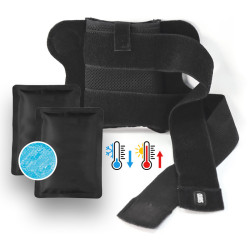 What is algodystrophy?
What is algodystrophy?
Algodystrophy, also known as complex regional pain syndrome (CRPS), is a chronic condition characterised by intense and prolonged pain, often accompanied by motor, sensory and vasomotor disorders. It usually occurs after trauma (fracture, sprain, surgery) or sometimes without any obvious cause. This condition can affect any part of the body, but the hands, feet, arms or legs are most commonly affected.
A mechanism that is still poorly understood
The exact mechanism of algodystrophy remains a mystery. However, it is known to involve a dysregulation of the autonomic nervous system and inflammatory processes.
What are the symptoms?
The manifestations of algodystrophy vary from person to person and can change over time. Typical symptoms include:
- Persistent pain: often described as a burning or stabbing pain.
- Skin changes: redness, shiny or dry skin, sometimes accompanied by swelling.
- Joint stiffness: a loss of mobility that gradually worsens.
- Muscle weakness: due to lack of use of the affected area.
- Abnormal sensations: tingling, numbness or intense cold sensation.
Who can be affected?
Algodystrophy can affect anyone, but it is more common in women, the elderly and individuals who have previously suffered trauma or surgery. Genetic predisposition and a history of inflammatory conditions may also play a role.
Stages of the disease
Algodystrophy generally progresses in two main phases:
- 1. Hot phase: inflammation, intense pain and heat in the affected area. This phase lasts from several weeks to a few months.
- 2. Cold phase: reduction in acute pain, but onset of joint stiffness and muscle atrophy. The skin becomes cold and pale.
Without treatment, the disease can lead to permanent loss of function in the affected area.
Treatment options
Although algodystrophy is difficult to treat, early and multidisciplinary management can improve patients' quality of life.
Medical treatments
- Painkillers: paracetamol, non-steroidal anti-inflammatory drugs or opioids to relieve pain.
- Antidepressants or anticonvulsants: used to treat neuropathic pain.
- Corticosteroid injections: to reduce inflammation.
- Nerve block: to relieve pain in severe cases.
Functional rehabilitation
Physiotherapy is essential for maintaining mobility and preventing atrophy. Gentle, regular exercise helps preserve the function of the affected limbs.
Complementary treatments
- Magnetic therapy: This technique, which uses magnetic fields to stimulate blood circulation and reduce inflammation, is increasingly being studied for its potential in chronic pain conditions such as algodystrophy.
- Heat or cold therapy: to relieve pain and improve local circulation. Discover the magnetic bandoflex with gel pocket.
- Acupuncture and hypnosis: these alternative approaches can alleviate symptoms by reducing stress and modulating pain perception.
Psychological support
Living with chronic pain can be challenging. Psychological support, such as cognitive behavioural therapy, can help to better manage the emotional impact of the condition.
Preventing algodystrophy
Although it is impossible to prevent all cases, certain precautions can reduce the risk:
- Early mobilisation after trauma or surgery: encourage rapid and appropriate rehabilitation.
- Monitoring symptoms: consult a doctor as soon as unusual or persistent pain occurs.
- Maintaining good general health: a balanced diet, regular physical activity and stress management can reduce risk factors.
Living with algodystrophy
Algodystrophy can disrupt daily life, but it is possible to regain balance with the right approach. It is crucial to surround yourself with a competent medical team, remain active as much as possible, and invest in pain management techniques.
Magnetic therapy, in particular, is a promising avenue. By stimulating natural healing processes, this approach could become a valuable addition to the management of chronic pain associated with algodystrophy.
A word of hope
While algodystrophy is a complex condition, advances in medicine and complementary therapies now offer real prospects for improvement. By combining traditional and alternative approaches, patients can hope for a significant improvement in their quality of life. You are not alone in facing this condition: solutions exist to help you regain your well-being and peace of mind.



